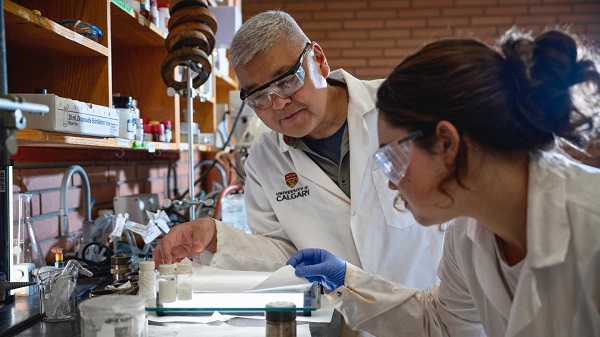Canadian Energy Centre
Unleashing Canada’s competitive advantage in energy and natural resources

From the Canadian Energy Centre
By Cody Ciona
Q&A with Bryan Detchou, senior director of natural resources, environment and sustainability with the Canadian Chamber of Commerce
Canada’s energy sector is one of the country’s greatest strengths, says an emerging leader with the Canadian Chamber of Commerce.
Bryan Detchou is the Chamber’s senior director of natural resources, environment and sustainability.
A former government relations consultant and staffer on Parliament Hill, in 2023 The Peak recognized Detchou as one of Canada’s young leaders shaping the country’s economy, culture and society.
The Chamber boasts a membership of over 200,000 businesses, including many energy-related companies. Detchou helps advocate for achieving the sector’s untapped potential.
Here’s what he shared with the Canadian Energy Centre:
CEC: Why does the Canadian Chamber of Commerce support Canada’s oil and natural gas sector?
BD: The mandate of the Canadian Chamber of Commerce is to support and be the leading voice for all businesses across the Canadian economy.
You cannot discuss the Canadian economy without recognizing the essential role of the oil and gas sector.
CEC: What role should Canada’s energy sector play in the 21st century Canadian and world economies?
BD: We believe that Canada’s energy and natural resources sectors are sources of pride and deserve strong support. These sectors hold the potential for Canada to exceed expectations on the global stage, positioning us as a key player in solving many of the world’s pressing challenges.
The conflict in Ukraine has exposed vulnerabilities in European and global energy security, underscoring the critical role Canada can play in addressing these issues. It is not only Canada’s responsibility to its citizens but also its duty to the global community to be a strong and reliable energy partner.
However, our failure to act decisively on energy security weakens our position and undermines our ability to contribute meaningfully to the reduction of global emissions.
CEC: How can Canadian energy businesses take a leadership position in emissions reduction?
BD: The majority of emissions reductions are being driven by the private sector, and we’re already seeing significant investments from various organizations. However, the challenge lies in the substantial capital required for these initiatives.
Before making major investment decisions, companies need a level of certainty and predictability in the markets they operate in—this is where the government can play a stronger role.
Regulatory hurdles, such as amendments to the Impact Assessment Act and the slow deployment of Investment Tax Credits, continue to create uncertainty.
We must understand that this is a global race. Canada is not the only country working to reduce greenhouse gas emissions and attract the necessary investment.
It is our responsibility to identify and leverage our competitive advantages. There is still much Canada can do to ensure its regulatory framework is conducive to attracting investment and driving environmental progress.
CEC: How is the federal greenwashing Bill C-59 impacting Canadian energy companies?
BD: From the outset, we have been fully engaged in addressing the challenges posed by this new legislation, starting with our involvement when the amendment was first introduced in the House of Commons committee in late May.
We testified before the Senate in early June, voicing the concerns of the industry, and have remained actively engaged ever since.
We unequivocally support the goal of ensuring that no Canadian company engages in deceptive marketing, whether in terms of product claims or the communication of their environmental commitments, particularly those aimed at combating climate change. Transparency and accountability are fundamental.
However, the law’s vague language and the absence of a clearly defined methodology have unfortunately created uncertainty across all sectors of the Canadian economy. This uncertainty hinders the ability of businesses to openly and confidently contribute to Canada’s ambitious climate goals.
Rather than driving environmental progress, the new law has inadvertently undermined the significant efforts already made by Canadian corporations, and by extension, the Canadian government. It has become a barrier to both innovation and meaningful environmental action.
The time has come for the government to revisit this legislation. The government should do now what it should have done in May and work collaboratively with industry stakeholders to develop a made-in-Canada regime that ensures corporate accountability and transparency while fostering, not stifling, innovation and environmental ambition.
Only by doing this can we achieve the climate objectives that Canada is striving for.
CEC: What does the Chamber believe are the best steps forward for Canada’s energy sector?
BD: The best way forward for Canada’s energy sector involves recognizing and leveraging our natural resources as one of the country’s greatest strengths, rather than a weakness. In the face of global challenges Canada’s energy sector must evolve to address these pressing issues.
We advocate for a balanced approach that includes diversifying the energy portfolio with investments in renewable technologies and innovations like carbon capture and storage and hydrogen, ensuring a clear and efficient regulatory framework to attract investment, and strengthening Indigenous partnerships to foster shared prosperity.
Promoting sustainable resource development to meet net-zero targets, expanding global market opportunities, and enhancing collaboration between government and industry are crucial.
By embracing our energy sector as a key asset, Canada can enhance its role on the global stage, support our allies, and combat climate change effectively. Unleashing the full potential of Canada’s natural resources is essential for securing energy security, achieving economic growth and driving long-term prosperity.
Alberta
Canada’s heavy oil finds new fans as global demand rises

From the Canadian Energy Centre
By Will Gibson
“The refining industry wants heavy oil. We are actually in a shortage of heavy oil globally right now, and you can see that in the prices”
Once priced at a steep discount to its lighter, sweeter counterparts, Canadian oil has earned growing admiration—and market share—among new customers in Asia.
Canada’s oil exports are primarily “heavy” oil from the Alberta oil sands, compared to oil from more conventional “light” plays like the Permian Basin in the U.S.
One way to think of it is that heavy oil is thick and does not flow easily, while light oil is thin and flows freely, like fudge compared to apple juice.
“The refining industry wants heavy oil. We are actually in a shortage of heavy oil globally right now, and you can see that in the prices,” said Susan Bell, senior vice-president of downstream research with Rystad Energy.
A narrowing price gap
Alberta’s heavy oil producers generally receive a lower price than light oil producers, partly a result of different crude quality but mainly because of the cost of transportation, according to S&P Global.
The “differential” between Western Canadian Select (WCS) and West Texas Intermediate (WTI) blew out to nearly US$50 per barrel in 2018 because of pipeline bottlenecks, forcing Alberta to step in and cut production.
So far this year, the differential has narrowed to as little as US$10 per barrel, averaging around US$12, according to GLJ Petroleum Consultants.
“The differential between WCS and WTI is the narrowest I’ve seen in three decades working in the industry,” Bell said.
Trans Mountain Expansion opens the door to Asia

Oil tanker docked at the Westridge Marine Terminal in Burnaby, B.C. Photo courtesy Trans Mountain Corporation
The price boost is thanks to the Trans Mountain expansion, which opened a new gateway to Asia in May 2024 by nearly tripling the pipeline’s capacity.
This helps fill the supply void left by other major regions that export heavy oil – Venezuela and Mexico – where production is declining or unsteady.
Canadian oil exports outside the United States reached a record 525,000 barrels per day in July 2025, the latest month of data available from the Canada Energy Regulator.
China leads Asian buyers since the expansion went into service, along with Japan, Brunei and Singapore, Bloomberg reports. 
Asian refineries see opportunity in heavy oil
“What we are seeing now is a lot of refineries in the Asian market have been exposed long enough to WCS and now are comfortable with taking on regular shipments,” Bell said.
Kevin Birn, chief analyst for Canadian oil markets at S&P Global, said rising demand for heavier crude in Asia comes from refineries expanding capacity to process it and capture more value from lower-cost feedstocks.
“They’ve invested in capital improvements on the front end to convert heavier oils into more valuable refined products,” said Birn, who also heads S&P’s Center of Emissions Excellence.
Refiners in the U.S. Gulf Coast and Midwest made similar investments over the past 40 years to capitalize on supply from Latin America and the oil sands, he said.
While oil sands output has grown, supplies from Latin America have declined.
Mexico’s state oil company, Pemex, reports it produced roughly 1.6 million barrels per day in the second quarter of 2025, a steep drop from 2.3 million in 2015 and 2.6 million in 2010.
Meanwhile, Venezuela’s oil production, which was nearly 2.9 million barrels per day in 2010, was just 965,000 barrels per day this September, according to OPEC.
The case for more Canadian pipelines

Worker at an oil sands SAGD processing facility in northern Alberta. Photo courtesy Strathcona Resources
“The growth in heavy demand, and decline of other sources of heavy supply has contributed to a tighter market for heavy oil and narrower spreads,” Birn said.
Even the International Energy Agency, known for its bearish projections of future oil demand, sees rising global use of extra-heavy oil through 2050.
The chief impediments to Canada building new pipelines to meet the demand are political rather than market-based, said both Bell and Birn.
“There is absolutely a business case for a second pipeline to tidewater,” Bell said.
“The challenge is other hurdles limiting the growth in the industry, including legislation such as the tanker ban or the oil and gas emissions cap.”
A strategic choice for Canada
Because Alberta’s oil sands will continue a steady, reliable and low-cost supply of heavy oil into the future, Birn said policymakers and Canadians have options.
“Canada needs to ask itself whether to continue to expand pipeline capacity south to the United States or to access global markets itself, which would bring more competition for its products.”
Alberta
Nobel Prize nods to Alberta innovation in carbon capture

From the Canadian Energy Centre
‘We are excited to bring this made-in-Canada innovation to the world’
To the naked eye, it looks about as exciting as baking soda or table salt.
But to the scientists in the University of Calgary chemistry lab who have spent more than a decade working on it, this white powder is nothing short of amazing.
That’s because the material they invented is garnering global attention as a new solution to help address climate change.
Known as Calgary Framework-20 (CALF-20 for short), it has “an exceptional capacity to absorb carbon dioxide” and was recognized in connection with the 2025 Nobel Prize in Chemistry.
“It’s basically a molecular sponge that can adsorb CO2 very efficiently,” said Dr. George Shimizu, a UCalgary chemistry professor who leads the research group that first developed CALF-20 in 2013.
The team has been refining its effectiveness ever since.
“CALF-20 is a very exciting compound to work on because it has been a great example of translating basic science into something that works to solve a problem in the real world,” Shimizu said.
Advancing CCS
Carbon capture and storage (CCS) is not a new science in Alberta. Since 2015, operating projects in the province have removed 15 million tonnes of CO2 that would have otherwise been emitted to the atmosphere.
Alberta has nearly 60 proposed facilities for new CCS networks including the Pathways oil sands project, according to the Regina-based International CCS Knowledge Centre.
This year’s Nobel Prize in Chemistry went to three of Shimizu’s colleagues in Japan, Australia and the United States, for developing the earliest versions of materials like CALF-20 between 1989 and 2003.
Custom-built molecules
CALF-20 is in a class called metal-organic frameworks (MOFs) — custom-built molecules that are particularly good at capturing and storing specific substances.
MOFs are leading to new technologies for harvesting water from air in the desert, storing toxic gases, and capturing CO2 from industrial exhaust or directly from the atmosphere.
CALF-20 is one of the few MOF compounds that has advanced to commercial use.
“There has been so much discussion about all the possible uses of MOFs, but there has been a lot of hype versus reality, and CALF-20 is the first to be proven stable and effective enough to be used at an industrial scale,” Shimizu said.
It has been licensed to companies capturing carbon across a range of industries, with the raw material now being produced by the tonne by chemical giant BASF.
Carbon capture filter gigafactory
Svante Inc. has demonstrated its CALF-20-based carbon capture system at a cement plant in British Columbia.
The company recently opened a “gigafactory” in Burnaby equipped to manufacture enough carbon capture and removal filters for up to 10 million tonnes of CO2 annually, equivalent to the emissions of more than 2.3 million cars.
The filters are designed to trap CO2 directly from industrial emissions and the atmosphere, the company says.
Svante chief operating officer Richard Laliberté called the Nobel committee’s recognition “a profound validation” for the entire field of carbon capture and removal.
CALF-20 expansion
Meanwhile, one of Shimizu’s former PhD students helped launch a spinoff company, Existent Sorbents, to further expand the applications of CALF-20.
Existent is working with oil sands producers, a major steel factory and a U.S.-based firm capturing emissions from other point sources, said CEO Adrien Côté.
“The first users of CALF-20 are leaders who took the risk of introducing new technology to industries that are shrewd about their top and bottom lines,” Côté said.
“It has been a long journey, but we are at the point where CALF-20 has proven to be resilient and able to survive in harsh real-world conditions, and we are excited to bring this made-in-Canada innovation to the world.”
-

 Censorship Industrial Complex2 days ago
Censorship Industrial Complex2 days agoHow the UK and Canada Are Leading the West’s Descent into Digital Authoritarianism
-

 Business2 days ago
Business2 days agoCapital Flight Signals No Confidence In Carney’s Agenda
-

 International2 days ago
International2 days agoThe capital of capitalism elects a socialist mayor
-

 Justice23 hours ago
Justice23 hours agoCarney government lets Supreme Court decision stand despite outrage over child porn ruling
-

 Business23 hours ago
Business23 hours agoCarney’s budget spares tax status of Canadian churches, pro-life groups after backlash
-

 Daily Caller18 hours ago
Daily Caller18 hours agoUN Chief Rages Against Dying Of Climate Alarm Light
-

 Business1 day ago
Business1 day agoPulling back the curtain on the Carney government’s first budget
-

 Daily Caller1 day ago
Daily Caller1 day agoUS Eating Canada’s Lunch While Liberals Stall – Trump Admin Announces Record-Shattering Energy Report











